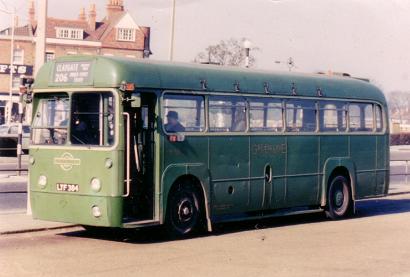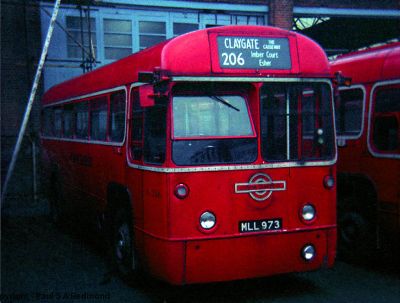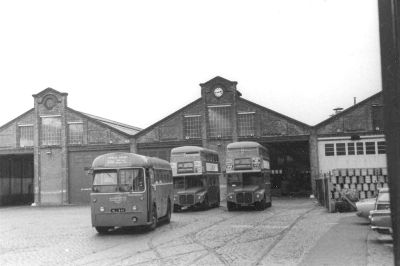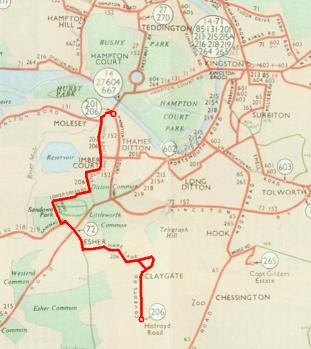|
|
 Red RF routes Red RF routes
Route 206
Page last updated 20 December
2014
The most out-of-the-way of the 'Kingston routes', the 206 was
one of the first four OMO RF routes, as well as being one of only
two routes to work as OMO throughout the
war (the other was the 252). It moved into Fulwell garage
the day after the trolleybuses finished.
Looking rather battered,
Green Line RF33 waits at Hampton Court Station. It was one of
those painted in the experimental light green livery, outshopped
from Aldenham in 1960 and running from Reigate on the 711,
then loaned to Fulwell for three months in early 1963 before
going on to Northfleet.
Photo Ian Armstrong collection
Dates of RF operation
10 Jun 59 to 21 Aug 76
Converted to OMO 18 Nov 64
(total 17 years 2 months, of which 5
years 5 months crew-operated)
Destinations
CLAYGATE Holroyd Road and HAMPTON COURT
STATION
RF Garages
NB Norbiton (Mon-Sat, 10 Jun
59 to 8 May 62)
K Kingston
(Sun, 5 Jul 59 to 8 May 62)
FW Fulwell
(9 May 62 to 17 Jul 76)
 Reason for single-deck operation Reason for single-deck operation
In its early days, it is likely that
economics, in the form of limited custom, was the reason for
OMO and therefore small single-deck operation; the bridge at
Claygate Station is currently signed at 14'3" but could probably
then have taken double-deckers if required. However, the
wartime extension to Imber Court (whether by Portsmouth Road or
Lower Green) took the route under low bridges carrying the main
railway line to Woking, so single-deck operation was unavoidable
from then onwards.
RF336 stands at Fulwell
Garage blinded for the short working to Claygate The
Causeway. Did the photographer set that up?
Photo ©
Paul Redmond
Route history
Although served by the Surbiton to Cobham
railway since 1885, Claygate did not have a bus service until the
introduction of the 206 in May 1936 to serve the growth in
housing. One-man operated by Kingston garage and
running between Claygate The Causeway and Esher every
half hour, the service initially used DA-class Darts. Cubs
were allocated briefly over the 1936/7 winter, but the
petrol-engined Darts were finally withdrawn at the outbreak of
war and replaced by Cubs.
 OMO Cub operation continued through the war years, with
the route being extended in 1942, first just to Lower Green in peak
hours and Saturday afternoons from March to May only, then
Monday to Saturday (except evenings) to Imber Court Ember
Lane from December - but via Portsmouth Road, not Lower
Green. OMO Cub operation continued through the war years, with
the route being extended in 1942, first just to Lower Green in peak
hours and Saturday afternoons from March to May only, then
Monday to Saturday (except evenings) to Imber Court Ember
Lane from December - but via Portsmouth Road, not Lower
Green.
OMO working came to an end, first time round, on 10 Sep 46
when the route was converted to 14T12 crew operation and extended
daily north of Imber Court to Hampton Court Station. A
further small extension came in June 1950 when the Claygate
terminus moved south to Holroyd Road.
After the trams came the
trolleybuses. After the trolleybuses came the RFs (and
RMs). Fulwell Depot on 7 Sep 69, and RFs have been in
residence for over 7 years. RF524 ready for the 206 stands in
front of two Routemasters on trolleybus replacement routes 281
(601) and 267 (667). RFs again stood on the forecourt
on the 30th anniversary RF celebration
on 22 Mar 09.
Photo © Peter
Esposito
Still (nominally) T-operated, the allocation moved to the new
Norbiton (NB) garage in May 1952, where the Ts were officially
replaced by TDs in October 1954. Two months later, the route
was diverted to run north and west of Sandown Park, finally serving
Lower Green again.
Just before the TDs were replaced at NB, Sunday operation moved
back to Kingston in May 1959. On 10 June, a batch of RFs
arrived at NB; these were part of the batch which had been
converted for one-man operation but which could not be introduced
as such, pending union agreement (which came five years
later). These doored buses converted the 206 and 264, ousting Norbiton's TDs. Others went to
Kingston for the 216; as K's first
RFs, they could not be introduced until crew training was completed
and they did so on 1 July. Sunday 206 operation therefore
waited three weeks for conversion.
Operation of the 206 moved to Fulwell as part of the
reshuffle following the end of the trolleybus era on 8 May 1962,
bringing garage journeys via Hampton Hill.
On 18 Nov 64, London Transport finally realised its ambition to
bring one-man operation back to the
Central Area, and four routes were converted - the 206, Norbiton's
201, Kingston's 216 and North Street's
deeply rural 250. The route then
continued unchanged for 12 years until 1976, when it was converted
to BL operation.
In summer 1969 or 1970, OMO
RF340 is seen (properly signed) with the driver selling a ticket
whilst laying over on the Hampton Court Station stand (still in use
today)
Photo Ian Armstrong
collection
However the end was near, and the route ran its last journey on
28 Oct 78, effectively absorbed into the 215. Steve Thomson lives in Claygate and
notes that the change was regarded there as "something of a triumph
for local pressure over LT. When the 206 went, Claygate at
last got a direct link to Surbiton & Kingston, the places in
demand then and now - and the 15-min service offered by the K3
today is probably the best that Claygate has ever had."
Towards the other end of the route, in Ember Lane, Richard
Day laments the passing of RFs running the 206. "If
only they were running now. I think it was a seven day a
week, every twenty minute service. These days we have the
515, which runs Monday to Saturday daytime, once an hour. Well,
that’s progress for you."

RF route in detail, with timing points
HAMPTON COURT STATION, Creek Road
(southbound only), Bridge Road, Esher Road, Imber Court Embercourt
Road, Ember Lane, Esher
Station Rd, Lower Green Road, Lower Green Road,
More Lane, Esher Green (“Catos Hill”), Lammas Lane, Esher High Street, Claremont
Lane, Millbourne Lane, Hare Lane, Claygate Station Approach, Hare
Lane, The Green, St Leonards Road, Common Road (“St Matthews
Terrace”), The Causeway (return via Church Road, High Street),
Claygate The
Causeway, Coverts Road, CLAYGATE Holroyd
Road. (In 1963/4, the route was diverted off Hare
Lane via Raleigh Drive and Loseberry Rd, in the Claygate
direction only)
1961 bus map ©
London Transport
Garage workings:
HAMPTON COURT STATION, Hampton Court
Way, Hampton Court Road, Kingston Bridge, KINGSTON GARAGE OR
NORBITON GARAGE
ESHER, Portsmouth Road, Kingston High
Street, KINGSTON GARAGE OR NORBITON GARAGE
HAMPTON COURT STATION, Hampton Court
Road, High Street Hampton, High Street Hampton Hill, Wellington
Road, FULWELL GARAGE. These journeys were worked in service
(see faretable).
More 206 photos here.
Frequency
| Year |
Mon-Fri |
Sat |
Sun |
| 1936 |
30 mins |
30 mins |
30 mins |
| 1938 |
30 mins |
30 mins |
30 mins |
| 1941 |
13-19 mins |
13-19 mins |
15-30 mins |
| 1946 |
20 mins * |
20 mins * |
15-30 mins |
| 1951 |
11-22 mins * |
11-22 mins * |
15-30 mins |
| 1953 |
11-24 mins * |
11-24 mins * |
15-30 mins |
| 1959 |
11-30 mins * |
24-30 mins * |
30 mins |
| 1964 |
12-20 mins |
20 mins |
30-60 mins |
| 1969 |
10-35 mins |
21-22 mins |
32-69 mins |
| 1971 |
10-35 mins |
21-22 mins |
32-69 mins |
| 1976 |
11-35 mins |
21-22 mins |
63-128 mins |
* more frequent Esher-Claygate
The route took 24-28 minutes between
Hampton Court and Claygate. The July 1967 timetable is
here.
Faretable
The May 1965 faretable is
here.
RF allocation
PVR 1959 (Jun): Mon-Fri 5 (NB), Sat 4 (NB), Sun 2
(K)
PVR 1961 (Aug): Mon-Fri 5 (NB), Sat 4 (NB), Sun 1
(K)
PVR 1962 (May): Mon-Fri 5, Sat 4, Sun 2 (all
FW)
PVR 1962 (Oct): Mon-Fri 5, Sat 3, Sun 2
PVR 1964 (OMO, Nov): Mon-Fri 6, Sat 4, Sun 3
PVR 1965 (Aug): Mon-Fri 7, Sat 5, Sun 3
PVR 1970 (Jan): Mon-Fri 6, Sat 4, Sun 3
PVR 1971 (Mar): Mon-Fri 6, Sat 4, Sun 1
PVR 1973 (Dec): Mon-Fri 6, Sat 4 + 1 ex 201, Sun 1
Re-creation
The 206 was RF operated at our Kingston RF Event 2009.
RF326 pauses at Esher The
Bear during the 2009 Kingston event.
Photo © Steve
Bidey
|
|